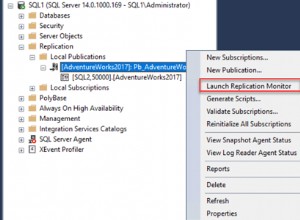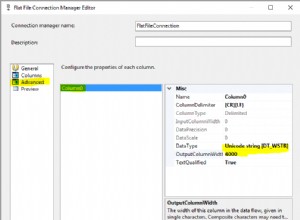Si consideri lo schema seguente in cui la terza tabella è la tabella helper anno/mese menzionata. Le tabelle helper sono molto comuni e possono essere riutilizzate naturalmente nel codice. Lascio a te il compito di caricarlo con dati di data sostanziali. Nota tuttavia il modo in cui la data di fine di ogni mese è stata messa insieme per quelli di noi che vogliono lavorare meno, consentendo al motore db di calcolare gli anni bisestili per noi.
Potresti avere solo una colonna in quella tabella di supporto. Ma ciò richiederebbe l'uso di chiamate di funzione per le date di fine in alcune delle tue funzioni e ciò significa più lentezza. Ci piace veloce.
Schema
create table workerRecords
( id int auto_increment primary key,
the_date date not null,
staff_no int not null
);
-- truncate workerRecords;
insert workerRecords(the_date,staff_no) values
('2016-06-10',1),
('2016-06-09',1),
('2016-05-09',1),
('2016-04-09',1),
('2016-03-02',2),
('2016-07-02',2);
create table workers
( staff_no int primary key,
full_name varchar(100) not null
);
-- truncate workers;
insert workers(staff_no,full_name) values
(1,'David Higgins'),(2,"Sally O'Riordan");
Tabella di supporto di seguito
create table ymHelper
( -- Year Month helper table. Used for left joins to pick up all dates.
-- PK is programmer's choice.
dtBegin date primary key, -- by definition not null
dtEnd date null
);
-- truncate ymHelper;
insert ymHelper (dtBegin,dtEnd) values
('2015-01-01',null),('2015-02-01',null),('2015-03-01',null),('2015-04-01',null),('2015-05-01',null),('2015-06-01',null),('2015-07-01',null),('2015-08-01',null),('2015-09-01',null),('2015-10-01',null),('2015-11-01',null),('2015-12-01',null),
('2016-01-01',null),('2016-02-01',null),('2016-03-01',null),('2016-04-01',null),('2016-05-01',null),('2016-06-01',null),('2016-07-01',null),('2016-08-01',null),('2016-09-01',null),('2016-10-01',null),('2016-11-01',null),('2016-12-01',null),
('2017-01-01',null),('2017-02-01',null),('2017-03-01',null),('2017-04-01',null),('2017-05-01',null),('2017-06-01',null),('2017-07-01',null),('2017-08-01',null),('2017-09-01',null),('2017-10-01',null),('2017-11-01',null),('2017-12-01',null),
('2018-01-01',null),('2018-02-01',null),('2018-03-01',null),('2018-04-01',null),('2018-05-01',null),('2018-06-01',null),('2018-07-01',null),('2018-08-01',null),('2018-09-01',null),('2018-10-01',null),('2018-11-01',null),('2018-12-01',null),
('2019-01-01',null),('2019-02-01',null),('2019-03-01',null),('2019-04-01',null),('2019-05-01',null),('2019-06-01',null),('2019-07-01',null),('2019-08-01',null),('2019-09-01',null),('2019-10-01',null),('2019-11-01',null),('2019-12-01',null);
-- will leave as an exercise for you to add more years. Good idea to start, 10 in either direction, at least.
update ymHelper set dtEnd=LAST_DAY(dtBegin); -- data patch. Confirmed leap years.
alter table ymHelper modify dtEnd date not null; -- there, ugly patch above worked fine. Can forget it ever happened (until you add rows)
-- show create table ymHelper; -- this confirms that dtEnd is not null
Quindi questa è una tabella di supporto. Installalo una volta e dimenticalo per qualche anno
Nota :Non dimenticare di eseguire lo stmt di aggiornamento di cui sopra
Test rapido per la tua query
SELECT DATE_FORMAT(ymH.dtBegin,'%b %Y') as month,
ifnull(COUNT(wr.the_date),0) as total_records,@soloName as full_name
FROM ymHelper ymH
left join workerRecords wr
on wr.the_date between ymH.dtBegin and ymH.dtEnd
and wr.staff_no = 1 and wr.the_date between '2016-04-01' and '2016-07-31'
LEFT JOIN workers w on w.staff_no = wr.staff_no
cross join (select @soloName:=full_name from workers where staff_no=1) xDerived
WHERE ymH.dtBegin between '2016-04-01' and '2016-07-31'
GROUP BY ymH.dtBegin
order by ymH.dtBegin;
+----------+---------------+---------------+
| month | total_records | full_name |
+----------+---------------+---------------+
| Apr 2016 | 1 | David Higgins |
| May 2016 | 1 | David Higgins |
| Jun 2016 | 2 | David Higgins |
| Jul 2016 | 0 | David Higgins |
+----------+---------------+---------------+
Funziona bene. La prima tabella MySQL è la tabella Helper. Un join sinistro per inserire i record del lavoratore (consentendo null). Fermiamoci qui. Dopotutto, questo era il senso della tua domanda:dati mancanti . Infine la tabella di lavoro in un cross join.
Il cross join è inizializzare una variabile (@soloName ) è il nome del lavoratore. Considerando che lo stato nullo delle date mancanti come richiesto viene rilevato correttamente tramite ifnull() funzione che restituisce 0, non abbiamo quel lusso per il nome di un lavoratore. Ciò forza il cross join .
Un cross join è un prodotto cartesiano. Ma poiché è una singola riga, non soffriamo dei normali problemi che si verificano con i cartesiani che causano molte righe nel set di risultati. Comunque funziona.
Ma qui c'è un problema:è troppo difficile mantenere e collegare i valori in 6 punti come si può vedere. Quindi considera di seguito un processo memorizzato per esso.
Proc memorizzato
drop procedure if exists getOneWorkersRecCount;
DELIMITER $$
create procedure getOneWorkersRecCount
(pStaffNo int, pBeginDt date, pEndDt date)
BEGIN
SELECT DATE_FORMAT(ymH.dtBegin,'%b %Y') as month,ifnull(COUNT(wr.the_date),0) as total_records,@soloName as full_name
FROM ymHelper ymH
left join workerRecords wr
on wr.the_date between ymH.dtBegin and ymH.dtEnd
and wr.staff_no = pStaffNo and wr.the_date between pBeginDt and pEndDt
LEFT JOIN workers w on w.staff_no = wr.staff_no
cross join (select @soloName:=full_name from workers where staff_no=pStaffNo) xDerived
WHERE ymH.dtBegin between pBeginDt and pEndDt
GROUP BY ymH.dtBegin
order by ymH.dtBegin;
END$$
DELIMITER ;
Testa il processo memorizzato un certo numero di volte
call getOneWorkersRecCount(1,'2016-04-01','2016-06-09');
call getOneWorkersRecCount(1,'2016-04-01','2016-06-10');
call getOneWorkersRecCount(1,'2016-04-01','2016-07-01');
call getOneWorkersRecCount(2,'2016-02-01','2016-11-01');
Ah, molto più facile lavorare con (in PHP, c#, Java, lo chiami). La scelta è tua, processo memorizzato o meno.
Proc memorizzato bonus
drop procedure if exists getAllWorkersRecCount;
DELIMITER $$
create procedure getAllWorkersRecCount
(pBeginDt date, pEndDt date)
BEGIN
SELECT DATE_FORMAT(ymH.dtBegin,'%b %Y') as month,ifnull(COUNT(wr.the_date),0) as total_records,w.staff_no,w.full_name
FROM ymHelper ymH
cross join workers w
left join workerRecords wr
on wr.the_date between ymH.dtBegin and ymH.dtEnd
and wr.staff_no = w.staff_no and wr.the_date between pBeginDt and pEndDt
-- LEFT JOIN workers w on w.staff_no = wr.staff_no
-- cross join (select @soloName:=full_name from workers ) xDerived
WHERE ymH.dtBegin between pBeginDt and pEndDt
GROUP BY ymH.dtBegin,w.staff_no,w.full_name
order by ymH.dtBegin,w.staff_no;
END$$
DELIMITER ;
Prova rapida
call getAllWorkersRecCount('2016-03-01','2016-08-01');
+----------+---------------+----------+-----------------+
| month | total_records | staff_no | full_name |
+----------+---------------+----------+-----------------+
| Mar 2016 | 0 | 1 | David Higgins |
| Mar 2016 | 1 | 2 | Sally O'Riordan |
| Apr 2016 | 1 | 1 | David Higgins |
| Apr 2016 | 0 | 2 | Sally O'Riordan |
| May 2016 | 1 | 1 | David Higgins |
| May 2016 | 0 | 2 | Sally O'Riordan |
| Jun 2016 | 2 | 1 | David Higgins |
| Jun 2016 | 0 | 2 | Sally O'Riordan |
| Jul 2016 | 0 | 1 | David Higgins |
| Jul 2016 | 1 | 2 | Sally O'Riordan |
| Aug 2016 | 0 | 1 | David Higgins |
| Aug 2016 | 0 | 2 | Sally O'Riordan |
+----------+---------------+----------+-----------------+
Il cibo da asporto
Le tabelle di supporto sono state utilizzate per decenni. Non aver paura o imbarazzo nell'usarli. In effetti, a volte è quasi impossibile provare a portare a termine un lavoro speciale senza di loro.




